Have you ever tried kinetic sand? I used it all the time with my children when they were younger. It is an amazingly satisfying sensory experience. Kinetic sand can be molded more easily and makes much less of a mess than real sand (bonus). It also does not dry or stick to surfaces, which makes it perfect for indoor use. All it takes is a few simple ingredients to make. The recipe I am sharing with you was developed as a soothing tool for children with special needs.
Best Ages for This Activity
This activity is great for 1 to 5-year-old children (in fact, it feels so good to play with kinetic sand that I won’t be surprised if the adults in your household can’t help playing with it too!)
How to Make It
Supplies
- 5 cups of play sand – you can use any kind of sand as long as it is sanitary for your child to play with. The one you purchase can be coloured too!
- 1 cup + 3 tablespoons of corn starch (you can substitute flour for cornstarch if you’d like)
- ½ teaspoon of dish washing soap
- 1 cup of water
- 2 large bowls for mixing
Optional Supplies
- Any airtight container for storage (or a large freezer Ziploc bag)
- You can also add a teaspoon of essential oil to make it scented and even more soothing!
Prepare
- Pour the sand in a large bowl (if you don’t use purchased play sand, which we recommend, make sure the sand you use is completely dry)
- Mix in the cornstarch, in the same bowl
- In a separate bowl, mix the water with the dish soap
- Add the soap mixture to the sand mixture and combine thoroughly
- Voilà! Your sand is ready for play
Store
Store kinetic sand in an airtight container to keep its consistency. If you feel it is getting too dry, you can add a few drops of water and mix well. If you sand starts to smell, throw it out and make a fresh batch.
Learning Opportunities
Kinetic sand is used for children with special needs, as it develops their sensory awareness, and has a calming effect. It is wonderful for babies for the same reason – it is ideal for sensory play as well as fine motor skills, which are both critical for writing. As its name implies, thanks to the addition of a polymer, regular play sand develops properties of motion (becoming kinetic). Your child will experience, through playing with kinetic sand, how force affects motion (engineering). Making the sand is excellent for math (measuring, quantities, mass) and science (by seeing how the different ingredients interact with each-other). Kinetic sand is a wonderful S.T.E.M. activity!
Children and adults alike will like the calming effects of manipulating the sand through their fingers and experience its calming effects. This type of play helps regulate emotions and encourages mindfulness. It also provides a great activity for children to play on their own.
Extended Learning Opportunities
- You can add cookie cutters and other kitchen molds and utensils to the sand, to further fine motor skills learning.
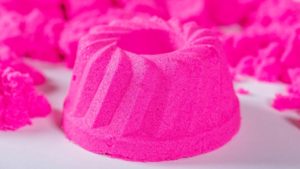
- Have a pretend “day at the beach”. Put on your swimsuits, sunglasses, set up a large Tupperware by a sunny window, bring all your sand toys and build sandcastles! (dramatic play and writing)
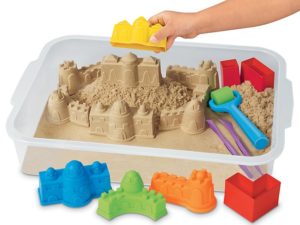
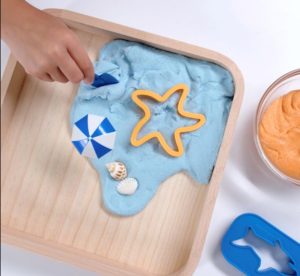
- Further play by making and storing different colours of sand. Try mixing the colours to see what happens (science and math)

- Add trucks for a construction site! (dramatic play)
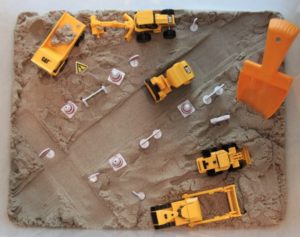
- Further play by adding toys your child can stamp with (science and writing). You can also stamp animals or dinosaurs for dramatic play using rubber stamps (see toys suggested below for ideas).
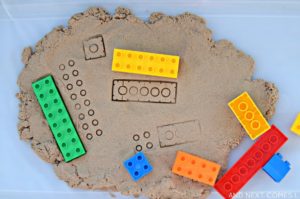
- Practice writing words with letter stamps (writing)
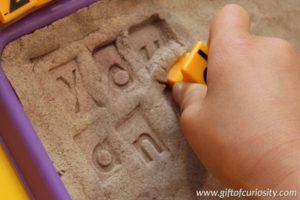
Things to Keep in Mind
Please keep in mind that young children need adult supervision at all times. Sand is better in the sandbox and not in the mouth.
Books and Toys You Might Like
Click the images below to purchase these products.
Books for babies to 2-year old’s












